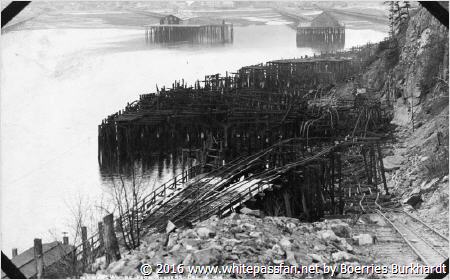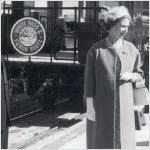Disastrous Fire - December 18, 1914
Disastrous Fire

Image of the destroyed Moose Warf
Disastrous Fire
Moore’s Wharf and Buildings are Burned at Skagway
The most disastrous fire Skagway has had since she was founded in the early fall of 1897, more than seventeen years ago, occurred last Saturday evening when at 5:55 o’clock an alarm was sounded and announcement made that Moore’s wharf was on fire. Two hours later all that remained of the wharf and long line of warehouses which had stood on it were smoking stubs of the piles which had supported the wharf and buildings. Everything on the long wharf from above the office clear down to the lower end, including a portion of the approach to the ore bunkers south of the wharf, was destroyed. The ore bunkers were saved, thanks to the U. S. Army tender, steamer Peterson, which in answer to a telegram,, arrived from Fort William H. Seward with a couple of dozen men whom a captain directed, with such skill and discipline in passing water and removing connections that the headway of the fire was checked before the ore bunkers were reached.
There are various theories as to why the flames could not be suppressed while yet in the incipient stage. One is that the fire, when first discovered, was burning in the immediate location of the water hydrant, the only one on the long wharf, and that it, the hydrant, could not be reached. Another story is that there was no wrench at hand with which to turn the cap of the hydrant, and yet another is that there was no water in the pipe had the hydrant been reached and had the cap of the hydrant been removed. Of these many stories the first is said to be the most reliable.
The fire is believed to have been started from a cinder dropped from the firebox of a locomotive which had been in use that day on the track immediately behind and adjoining the wharf, as the fire started on the railroad and was later communicated to the wharf. When discovered by the watchman it had made but little headway but by the time assistance arrived it was beyond control, a terrific wind from the north fanning the flames.
At the time of the fire there was not to exceed $500 worth of freight on the wharf, about half of which was coal. Had it occurred during the season of open navigation on the rivers and lakes the loss might have run into hundreds of thousands of dollars. The property was insured but to what extant has not been accurately learned although it is said to be for considerable amount.
Moore’s wharf was built seventeen years ago this winter by the late Captain William Moore and a number of English associates. At that time it cost something like a quarter of a million dollars. About eight months ago it passed into the hands of the White Pass Company by which it was owned when destroyed.
Besides the wharf and buildings the railroad company lost 21 freight cars in the fire. Three of the cars were refrigerators.
It will be imperative on the company to construct a wharf and warehouses without delay and to that end work will no doubt be inaugurated in the very near future and as soon as the insurance can be adjusted..
The fire which was witnessed by a number of Whitehorse people who had arrived at Skagway on Friday’s excursion train, lighted up the entire side of the mountain at the foot of which the wharf lay - a sight which will be remembered by all present.
THE WHITEHORSE STAR - Friday December 18, 1914

